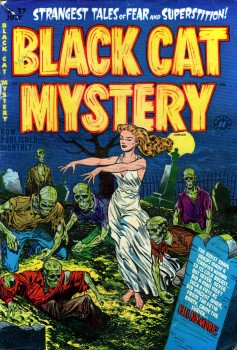
What Does “Pre-Code” Horror Mean?
The best horror comics were written in a time when the writers and illustrators were given free rein to express their art. Thanks to HBO’s Tales From the Crypt, most of us have heard of EC comics, The Crypt-Keeper, and titles like Vault of Horror, Crime SuspenStories and The Haunt of Fear. EC was the product of an era where criminals were rewarded for their evil deeds with acid in the face and murderers were savagely revenged by walking corpses in full graphic rendition.
EC wasn’t the only game in town, though. The Golden Age of comics welcomed a plethora of new horror magazines, and the crescendo built up to a point where there were so many competing titles that they would try to out-do each other by upping the shock and blood ante with each new issue. …Until kids’ parents started to notice just what their darlings were spending their Saturday afternoons reading. The government soon mandated that the comic-book industry be regulated, and the skimpy dresses and headless zombie freaks went away. Even today comics haven’t managed to capture quite the same flavor… the same celebration and reverence of sick and disgusting stories that came about in the days before the Comics Code Authority.
Golden: 1933-1955 (Pre-War & Wartime) Silver: 1955-1970 (1950s and 60s) Bronze: 1970-1985 (1970s and 80s) Modern: 1985-present (Current, Dark Age) |
A comic book’s era refers to it being a product of the times in which it was written. (It also refers to the size of the books if you are looking for polyethylene bags.) The beginning of the comic book industry as we know it began with the 1938 debut of Superman in Action Comics #1.
This new, Golden Age of graphic literature was rich with stories of detectives & gangsters, of romance, superheroes, and horror. But then the horror writers went too far, and there was a whole government inquest (remember the PMRC?) that resulted in the Comics Code Authority in 1954.
In 1956, Harvey Comics discontinued its horror comics, and the tone of scary magazines across the country was doused with a wet rag. The horror continued in the Silver Age, but as you might find in the first few issues of House of Mystery for example, the stories always ended with the supernatural elements being faked or a moral play where the bad guy gets his comeuppance.
In response to a new culture of enlightenment in the 1960s, the real golden age of comics soon arose. Its beginning was marked spectacularly by a single issue of Spider-Man in which his girlfriend Gwen Stacy dies at the hands of the Green Goblin. An era of innocence came abruptly to an end. The good-guy didn’t always win. People died.
That theme grew as the 70s progressed, and Bronze Age comics were then written for a Young Adult audience rather than selling the silly stories Fawcett used to publish with Captain Marvel and Mr. Tawny the Talking Tiger.
The 1980s ushered in a new, darker era of Modern Age comics with Batman: The Dark Knight Returns and Alan Moore’s Watchmen. This self-aware, post-modern trend inspired DC to start its own line of non-code approved books dealing with horror and the supernatural beginning with a landmark called The Sandman written by Neil Gaiman. The rise of DC’s Vertigo and a plethora of other independent publishers went hand-in-hand with the rise of the anti-hero, and no one seems to have looked back.
Print Copies
You’ll be hard-pressed to find a hard-copy of the original issues of this unique brand of art, but if you want to experience the terror while smelling fresh ink and turning crisp pages, you need look no further than the Internet.
 |
 |
-and- you can find its bi-monthly companion title at your local comic book store!
Haunted Horror (Comic Book)
 |
 |
 |
Electronic Versions
Most of these comic books have reverted to the public domain, though many of the best such as those once published by EC Comics and Atlas Comics (now owned by Marvel) have had their copyrights re-asserted and cannot be legally shared.
There are a number of websites sharing individual stories for those who are interested in discussing them with other connoisseurs of the art form, but none better than:
The Digital Comic Museum offers a way to download the entire comic books in .cbr or .cbz format directly, and The Internet Archive is another great source for these and other downloads (like Old Time Radio horror shows!)
To read .cbz or .cbr files you’ll need a program like ComicRack or Cdisplay Ex.
*
If you have a Kindle, Moon+ Reader is a great app.
*Just be aware– some installers may try to sneak ad-ware onto your computer. The programs will still install properly if you decline all the offers.
Downloads: The 10 Scariest Pre-Code Horror Comics Stories The 20 Scariest Pre-Code Horror Comics Stories Sources & Reviews: |
